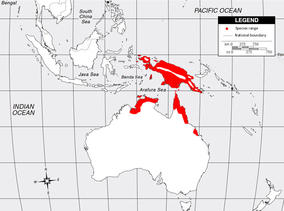You are here
Species
Cracticus quoyi Lesson & Garnot, 1827
Nomenclature
-
Family: CracticidaeGenus: Cracticus
SUMMARY
Nominate race is black, brighter, glossy blue-black on back, duller ventrally, and becoming duller with wear; tail long, appears square-tipped at rest but rounded in flight; iris brown; bill blue-grey or milky blue, distal third black; legs dark grey or black. Sexes similar in plumage, male (wing 180 mm) slightly larger then female (wing 176mm). Juvenile differs from adult in having underparts dull black or brownish-black, iris brownish-yellow, bill pale grey, legs dark grey; immature like adult, but underbody and most of upperwing duller black-brown, contrasting with glossy head, neck and back, area of bluish coulour at base of bill becoming more extensive with age. Races differ mostly in size and in bill morphology: alecto is larger then nominate (wing of male 190 mm,of female 181 mm), intermediate in size between following two, immature dull black; spaldingi is largest race ( 42-44 cm, wing of male 198 mm, of female 186 mm), with slender bill, immature dull black; jardini is smaller then previous ( 167g; wing of male 181 mm, of female 176 mm), with short, slender bill, immature dull black; rufescens is smaller then last (33-38 cm, male 161 g, wing of male 174 mm, of female 166 mm), with short, slender bill, immature either rufous-black or dull black ( sometimes both types in same brood).Voice. Repertoire not well known; regional variation reported, but not characterized. Vocalizations loud. Song a rich, melodious yodelling with some clear liquid notes, sometimes ( e.g. dawn in breeding season) given in long bouts. Antiphonal duets by presumed males and female, especially at start of breeding season. In early morning male gives clonking “gronk, gronk” call from perch in canopy.


